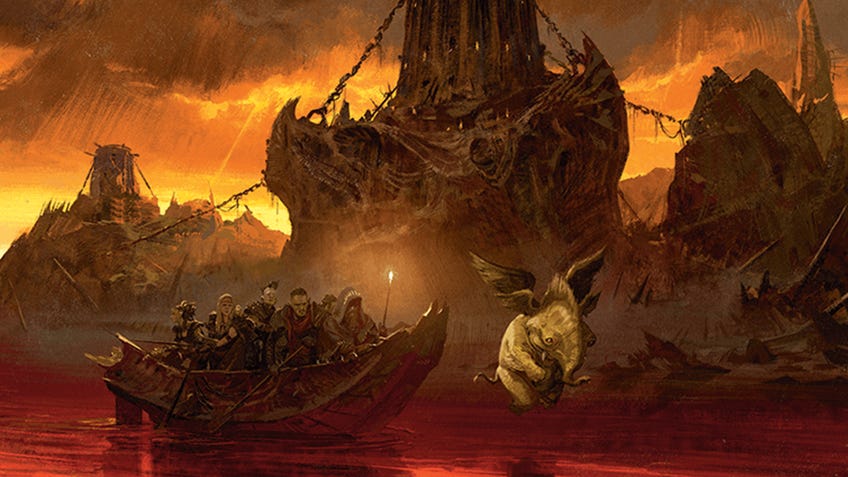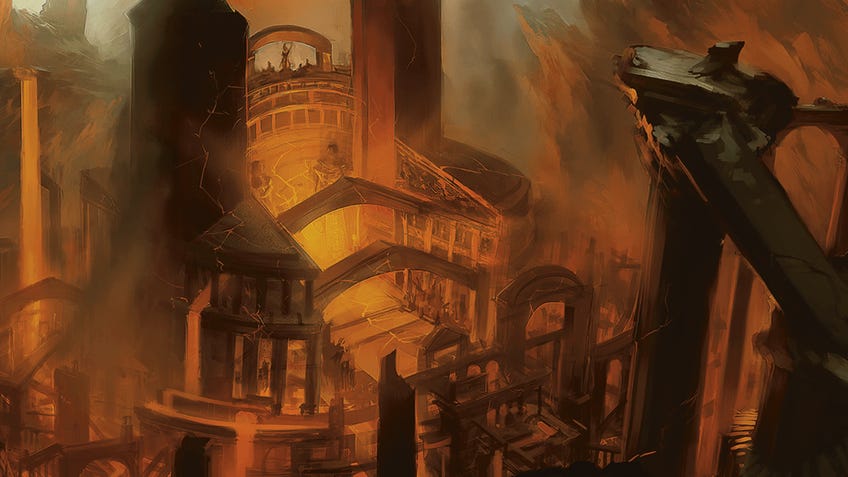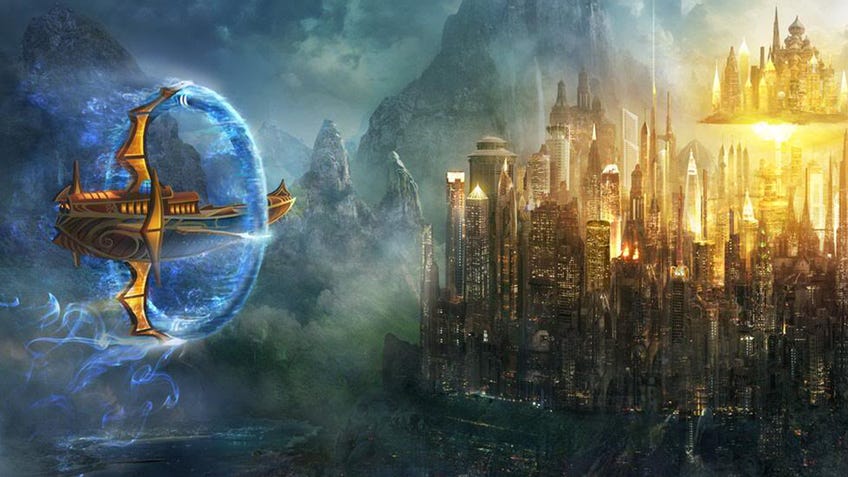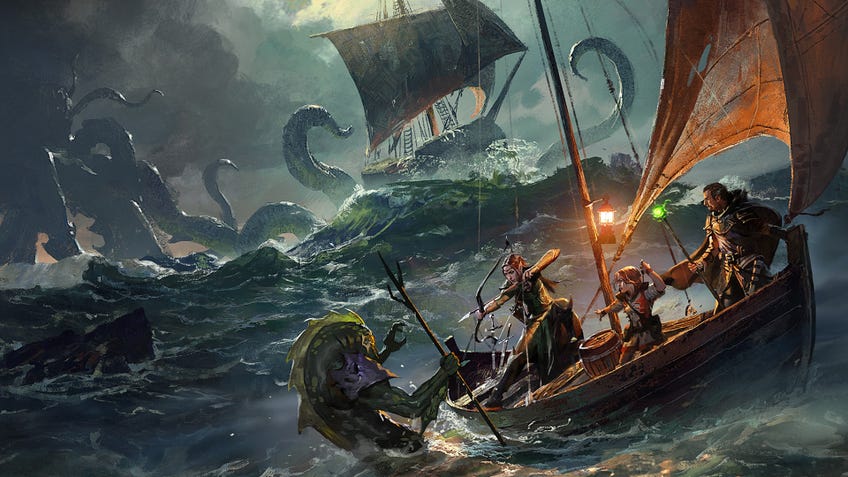7 best Dungeons & Dragons settings for your next campaign
Dive into a fiery plane of demons or sail across dark stormy waters in these exciting D&D locales.
The universe of Dungeons & Dragons is filled with some very strange places indeed. Thanks to the diversity of settings and locales you can find in the official D&D world-building materials, it’s possible to hold a campaign in a quaint village populated by gnomes or a hellish prison designed to hold the most devious beings known to sentient kind - both using the exact same system. The range of possible locations players can visit during their adventures is part of what makes D&D such a popular roleplaying game.
The term ‘settings’ can be a little confusing when it comes to Dungeons & Dragons, as it can refer to entire planes of existence as well as singular continents. It’s not really about the size or geographical location of a setting that makes it stand apart from others, it’s more to do with what that locale can offer compared to its contemporaries. The Forgotten Realms is one plane of existence in the D&D universe, but within that plane are many, many different settings for players to explore - ranging from bustling cities filled with political intrigue to terrifying desolate wastelands stuffed to the brim with beasties.
Best Dungeons & Dragons settings
- Sword Coast: A large stretch of coastline based in Faerûn, this setting is home to one of the most iconic locations in D&D history - the city of Waterdeep.
- Avernus: The first layer of the Nine Hells of Baator, this fiery land is home to all sorts of devils and demons who can and will manipulate, betray and murder unsuspecting visitors.
- Icewind Dale: This arctic tundra promises harsh conditions and deadly monsters for any traveller brave enough to enter its snowy depths.
- Theros: Heavily inspired by ancient Greek history and culture, this Magic: The Gathering world is brought to life in a D&D setting.
- Eberron: A steampunk-inspired setting based in the world of Khorvaire, players can expect to fly around in airships and encounter dinosaurs.
- Saltmarsh: Along the coast of the Azure Sea lies a little fishing village whose idyllic way of life is being destroyed by smugglers and much worse.
- Wildemount: A continent located in the world of Exandria - created by Critical Role DM Matthew Mercer - this setting is home to all sorts of intriguing cultures.
The D&D settings that most speak to you will really depend upon what you most enjoy about playing the fantasy roleplaying game. If dangerous encounters with deadly beasts is what you seek, one of the less hospitable locales on this list is more likely to be up your alley. Alternatively, you might be looking for an opportunity to meet friendlier folk, which likely means you’ll benefit from visiting somewhere populated by people and creatures who aren’t just going to try and stab you the moment you arrive. There’s a good mixture of both in this list, with some settings containing areas where conflict or peace could occur - entirely depending on what you do there. Decide on your next Dungeons & Dragons destination, using our guidebook to the best Dungeons & Dragons settings.
1. Sword Coast
This sizable stretch of coastline contains dozens of landmarks and places to explore

Technically, the Sword Coast is divided into two different sections - Sword Coast and Sword Coast North - but we’re wrapping them into one complete setting for the purposes of this first entry. Featured in the Sword Coast Adventurer’s Guide, as well as multiple campaign books including Waterdeep: Dragon Heist and Waterdeep: Dungeon of the Mad Mage, this D&D setting is iconic for providing roleplaying experiences steeped in the kind of classic fantasy that Dungeons & Dragons is known for. Hills, forests, mountains, settlements and even an errant swamp feature among the Sword Coast’s many attractions.
The main draw of the Sword Coast are the key locations of Neverwinter Wood - the dwelling of elves and mischievous fey creatures - Baldur’s Gate and Waterdeep. There’s a ton of history to all of these places if you have the time to go snooping into them, which means that there’s a lot of culture to soak in. Baldur’s Gate is a port city that serves as a trading hub for the entire Sword Coast, but it also happens to harbour worshippers of Bane and Bhaal - two outworldly evil deities. The metropolis features prominently within the Dungeons & Dragons video game series Baldur’s Gate, which recently saw a third entry, and has connections to another setting on this list.
Waterdeep is another notable city located on the Sword Coast, one that’s more renowned for its influential inhabitants and potential for shady dealings. The city is home to both a notorious thieves’ guild - whose exploits have made them a number one target for the local law enforcement - and Undermountain, an enormous dungeon hidden beneath Waterdeep containing all manner of dangers too alluring for any adventurer to resist. If you want your next foray into Dungeons & Dragons to have all the hallmarks of a classic campaign, the Sword Coast is a great choice of setting.
Buy Sword Coast Adventurer's Guide on Amazon US and Amazon UK.
2. Avernus
One of D&D’s most unusual settings promises spicy adventures and characters who run hot

The afterlife is not a mystery in the world of Dungeons & Dragons. Mortals know where they could end up if they live their life in a less than moral way, as there is an intricate system of planes designed to hold all sorts of bad people. One of these planes is the Nine Hells of Baator, a fiery world where people who followed a lawful evil alignment usually find themselves when death finally claims them. Avernus is the topmost circle of Baator and is described as being a barren wasteland filled with snake pits, scattered magma pools and the occasional flying fireball.
The circle of Avernus is also home to an army of devils whose entire purpose is to eternally battle the forces of demons intent on invading the Nine Hells. Devils and demons are directly opposed creatures - devils being lawful evil and demons following a chaotic evil path - which means that they rather dislike each other, to put it lightly. Any adventurers unfortunate enough to find themselves wandering the deserts of Avernus won’t just have to survive the burning rivers of lava and raining fireballs, but the battlegrounds of this never-ending Blood War too. Not to mention the mischievous imps, vicious Abishai and winged Spinagon that lurk around Avernus, waiting for unsuspecting victims.
So why would you ever want to come here? In the case of adventure Baldur’s Gate: Descent into Avernus, player characters find themselves getting involved in the aforementioned devil/demon conflict thanks to archdevil Zariel and the threat presented by her newly-constructed infernal warmachines. Avernus is the kind of place designed for a party that’s looking to take on a real big bad; the kind of evil that can’t exist on the mortal planes simply because it’s too dangerous for living people. Which is why Avernus is the perfect D&D setting for players who want to get knee-deep in the hottest action possible - quite literally.
Buy Baldur's Gate: Descent into Avernus from Amazon US and Amazon UK.
3. Icewind Dale
The freezing snows of this setting aren’t the chilliest thing players will encounter.

Far to the north lies a frozen wasteland whose icy planes promise death and disaster to those foolish enough to enter its depths. Icewind Dale is a snowy tundra located on the continent of Faerûn - which is also home to the Sword Coast - that offers very little in the way of civilisation but a lot when it comes to hazardous environments and dangerous beasts. There might be a scattering of settlements spread across the dale, which are mostly populated by the odd fisherman or dwarf working the mines hidden within the mountains, but for the most part this setting is primarily home to isolation. Considering that the winters in Icewind Dale can get as cold as -40℉, it’s unsurprising that there aren’t a lot of folk inhabiting this area of the world.
Which isn’t to say that there’s a lack of adventure to be had in Icewind Dale; just don’t expect a warm welcome from its people or its weather. The history of Icewind Dale is dotted with all manner of terrible events - including the time a necromancer used the local barbarian tribes for horrifying experiments - as well as some more exciting ones, such as the heroic endeavors of Drizzt Do’Urden, one of the most recognisable characters in Dungeons & Dragons lore. Should a party ever want to do a bit of sightseeing, they might just need to be wary of the remorhazes - enormous killer centipedes - roaming bands of frost giants and even a white dragon or two.
Icewind Dale has featured in several D&D properties, including a video game series of the same name and an adventure released last year called Icewind Dale: Rime of the Frostmaiden. This particular adventure provides players with three separate threats to cope with - including a tyrannical warlock, a hidden necropolis and a mournful deity - alongside all the usual dangers that the dale has to offer. Those players wanting to be challenged, frightened and frozen by their next Dungeons & Dragons setting need look no further than Icewind Dale.
Buy Icewind Dale: Rime of the Frostmaiden on Amazon US and Amazon UK.
4. Theros
A setting that makes the jump from Magic: The Gathering to the world of D&D

Believe it or not, Theros isn’t the first Dungeons & Dragons setting based on a Magic: The Gathering set - that particular honour goes to the steampunk-inspired Ravinca - but it’s certainly distinctive enough to catch the attention of any player or dungeon master. For those who might not be familiar with the collectible card game, Magic: The Gathering has a vast multiverse filled with all sorts of worlds and one of them is the land of Theros. Looking at Theros, it’s instantly obvious where its creators, James Wyatt and and F. Wesley Schneider, looked for inspiration. From fearsome hydra to meddling gods, Theros unashamedly is a love letter to ancient Greek myth and culture.
Apart from the character creation elements introduced in Theros, which enable players to create flawed heroes who were driven by their connection to a chosen god or fate, the most exciting aspect of the setting is easily its pantheon. Taken wholesale from Magic, Theros’ group of gods are fallible, bitter and more than willing to get mortals involved in divine matters. Unlike the deities of the wider Dungeons & Dragons universe, the gods of Theros are incredibly visible and present. Despite being associated with certain MTG mana colours and alignments these deities do not follow a set path of morals, and are instead driven by their own personal desires and feuds, which they will not hesitate to pull player characters into if they require their aid.
When not being a family counsellor to a pantheon of bickering deities, players can embark on epic adventures that are sure to have stories told about them for years to come. Theros is filled with opportunities for battling beasts, sailing vast seas and performing mighty feats - it really is just that extra. Players will also be able to interact with, and even create, minotaur and centaur characters, fully cementing Theros as being the setting of choice for lovers of ancient Grecian myths.
Buy Mythic Odysseys of Theros from Amazon US and Amazon UK.
5. Eberron
A setting inspired by noir films and steampunk is guaranteed to provide something unique

The creative history behind Eberron is a fascinating story that only adds to the setting’s unique identity. Designed by Keith Baker, the creator of the Gloom series of card games, Eberron was originally called The Thrilling Tales of Swords and Sorcery and found inspiration in steampunk and noir, taking cues from several beloved films such as Casablanca, Raiders of the Lost Ark and The Mummy (1999). Originally introduced in Dungeons & Dragons’ third edition, Eberron is a world made up of seven continents, with Khorvaire being the most populated and commonly visited one, and features a society torn apart by war but filled with boundless potential.
The people of Eberron may have many of the characteristics found in fantasy settings, such as an affinity for magic, but they’re far more technologically advanced. Players can expect to see ships flying through the sky, weapons augmented with machine enhancements and even an entire species of living artificial constructions called Warforged. Much of this technology was created and used in a conflict called The Last War, which has since concluded by the time player characters find themselves walking on Eberron’s soil.
Besides the machines, Eberron is remarkable for being a setting that’s positively stuffed full of weirdness. From Changelings and Shifters - playable species who are capable of altering their appearance at will - to psionic Kalashtar and actual dinosaurs, Eberron is a strange land that will almost certainly continue to surprise its players regardless of how many adventures they experience there. For something very different from the classic fantasy most often associated with Dungeons & Dragons, it’s hard to go wrong with a setting like Eberron.
Buy Eberron: Rising from the Last War from Amazon US and Amazon UK.
6. Saltmarsh
This sleepy fishing town is plagued by all sorts of terrors from the seas’ salty depths

To the naked eye, Saltmarsh may appear to be nothing more than your average, run of the mill coastal village in Salinmoor - a Viscounty of the country of Keoland. Its people make their money from the fresh fish that they catch each day, making it a serious means of trade for Saltmarsh. This fish might have made its way to the city of Seaton - if it hadn’t already been plundered and sacked by a band of roaming slavers. Despite being a small town, Saltmarsh has seen its fair share of troubles thanks to the smugglers and ne'er-do-wells that plague its waters, and that’s not even mentioning a certain cult that’s been lurking around its streets.
Saltmarsh is heavily featured in an anthology of D&D adventures called Ghosts of Saltmarsh, with the village playing host to all sorts of marine-based horrors from the hungry sahuagin - fish monstrosities that hide beneath the waves waiting for ships to sail above - to undead sailors that rise from their graves. The Sinister Secret of Saltmarsh has players encountering an evil alchemist who lives in a haunted house on the outskirts of the town, with the adventure eventually leading the party to a ghostly ship doomed to forever sail Saltmarsh’s waters. As a location, Saltmarsh is clearly inspired by Lovecraftian horror and history’s various smuggling towns.
Regardless of how quaint Saltmarsh might initially appear, it contains oodles of nasty secrets for players to unearth. There are definitely opportunities here for characters to explore the seas, if sailing is something they’re particularly keen on experiencing, as well as interact with some undoubtedly strange folk. Not necessarily the driest or safest setting Dungeons & Dragons has to offer, any wannabe seafaring characters shouldn’t miss out on the chance to release their sails in Saltmarsh.
Buy Ghosts of Saltmarsh on Amazon US and Amazon UK.
7. Wildemount
Explore an entire continent created by Critical Role’s own dungeon master

Wildemount is part of a world called Exandria which comes from the mind of Matthew Mercer, actor and dungeon master for the actual play YouTube series Critical Role, who was lead writer on the official Dungeons & Dragons sourcebook Explorer’s Guide to Wildemount. As a D&D setting Wildemount is filled with many different kinds of environments, from the sun-drenched city of Port Damali to the frozen north of Eiselcross, and is filled to the brim with all sorts of dangerous beings such as Aerion Abominations and giant sea turtles. What stands out most about Wildemount is not its lands or monsters, but its peoples, cultures and rich histories.
The campaign for season two of Critical Role has a heavy focus on deities and the conflict between the nations of the Dwendalian Empire and the Kryn Dynasty, both of which are heavily represented in Wildemount’s sourcebook. This continent has been shaped by the events of the calamity - a massiving outing of various traitor gods who had been scheming to do some pretty bad things - with its people deeming the worship of certain deities appropriate or forbidden. Wildemount is also in the midst of an epic war between two culturally opposing peoples, those of the Empire and the Dynasty, who are sure to play a central role in almost any one-shot or campaign that takes place in this setting.
Wildemount certainly has some incredible sights and encounters hidden in its more remote areas, such as ancient ruins containing the bodies of long dead behemoths or vast jungle islands holding sinister godlike beings. However, its most incredible aspects are the various societies, organisations and powers at play within both sides of its continent spanning conflict. For players itching for some political intrigue and cultural exploration, Wildemount provides more than enough opportunities to get stuck into some talkative situations.
Buy Explorer's Guide to Wildemount on Amazon US and Amazon UK.













